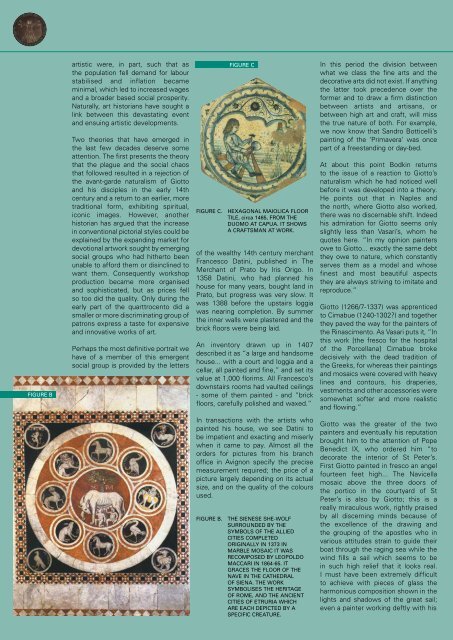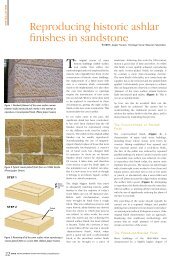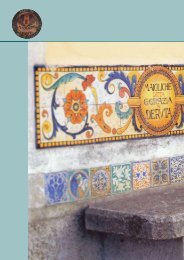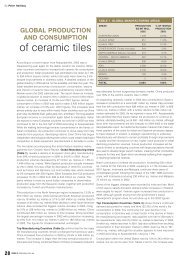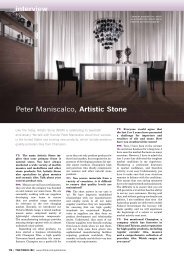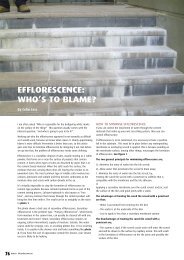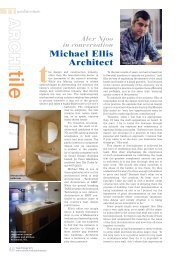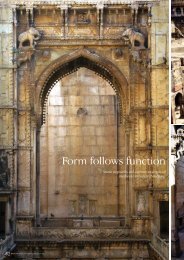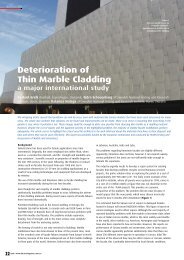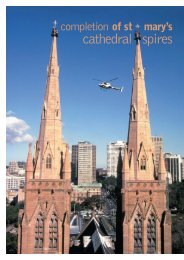A history of Italian tiles - Infotile
A history of Italian tiles - Infotile
A history of Italian tiles - Infotile
You also want an ePaper? Increase the reach of your titles
YUMPU automatically turns print PDFs into web optimized ePapers that Google loves.
figure B<br />
artistic were, in part, such that as<br />
the population fell demand for labour<br />
stabilised and inflation became<br />
minimal, which led to increased wages<br />
and a broader based social prosperity.<br />
Naturally, art historians have sought a<br />
link between this devastating event<br />
and ensuing artistic developments.<br />
Two theories that have emerged in<br />
the last few decades deserve some<br />
attention. The first presents the theory<br />
that the plague and the social chaos<br />
that followed resulted in a rejection <strong>of</strong><br />
the avant-garde naturalism <strong>of</strong> Giotto<br />
and his disciples in the early 14th<br />
century and a return to an earlier, more<br />
traditional form, exhibiting spiritual,<br />
iconic images. However, another<br />
historian has argued that the increase<br />
in conventional pictorial styles could be<br />
explained by the expanding market for<br />
devotional artwork sought by emerging<br />
social groups who had hitherto been<br />
unable to afford them or disinclined to<br />
want them. Consequently workshop<br />
production became more organised<br />
and sophisticated, but as prices fell<br />
so too did the quality. Only during the<br />
early part <strong>of</strong> the quarttrocento did a<br />
smaller or more discriminating group <strong>of</strong><br />
patrons express a taste for expensive<br />
and innovative works <strong>of</strong> art.<br />
Perhaps the most definitive portrait we<br />
have <strong>of</strong> a member <strong>of</strong> this emergent<br />
social group is provided by the letters<br />
figure C<br />
figure C. Hexagonal maiolica floor<br />
tile, circa 1465, from the<br />
duomo at capua. it shows<br />
a craftsman at work.<br />
<strong>of</strong> the wealthy 14th century merchant<br />
Francesco Datini, published in The<br />
Merchant <strong>of</strong> Prato by Iris Origo. In<br />
1358 Datini, who had planned his<br />
house for many years, bought land in<br />
Prato, but progress was very slow. It<br />
was 1388 before the upstairs loggia<br />
was nearing completion. By summer<br />
the inner walls were plastered and the<br />
brick floors were being laid.<br />
An inventory drawn up in 1407<br />
described it as “a large and handsome<br />
house... with a court and loggia and a<br />
cellar, all painted and fine,” and set its<br />
value at 1,000 florims. All Francesco’s<br />
downstairs rooms had vaulted ceilings<br />
- some <strong>of</strong> them painted - and “brick<br />
floors, carefully polished and waxed.”<br />
In this period the division between<br />
what we class the fine arts and the<br />
decorative arts did not exist. If anything<br />
the latter took precedence over the<br />
former and to draw a firm distinction<br />
between artists and artisans, or<br />
between high art and craft, will miss<br />
the true nature <strong>of</strong> both. For example,<br />
we now know that Sandro Botticelli’s<br />
painting <strong>of</strong> the ‘Primavera’ was once<br />
part <strong>of</strong> a freestanding or day-bed.<br />
At about this point Bodkin returns<br />
to the issue <strong>of</strong> a reaction to Giotto’s<br />
naturalism which he had noticed well<br />
before it was developed into a theory.<br />
He points out that in Naples and<br />
the north, where Giotto also worked,<br />
there was no discernable shift. Indeed<br />
his admiration for Giotto seems only<br />
slightly less than Vasari’s, whom he<br />
quotes here. “In my opinion painters<br />
owe to Giotto... exactly the same debt<br />
they owe to nature, which constantly<br />
serves them as a model and whose<br />
finest and most beautiful aspects<br />
they are always striving to imitate and<br />
reproduce.”<br />
Giotto (1266/7-1337) was apprenticed<br />
to Cimabue (1240-1302) and together<br />
they paved the way for the painters <strong>of</strong><br />
the Rinascimento. As Vasari puts it, “In<br />
this work [the fresco for the hospital<br />
<strong>of</strong> the Porcellana] Cimabue broke<br />
decisively with the dead tradition <strong>of</strong><br />
the Greeks, for whereas their paintings<br />
and mosaics were covered with heavy<br />
lines and contours, his draperies,<br />
vestments and other accessories were<br />
somewhat s<strong>of</strong>ter and more realistic<br />
and flowing.”<br />
In transactions with the artists who<br />
painted his house, we see Datini to<br />
be impatient and exacting and miserly<br />
when it came to pay. Almost all the<br />
orders for pictures from his branch<br />
<strong>of</strong>fice in Avignon specify the precise<br />
measurement required; the price <strong>of</strong> a<br />
picture largely depending on its actual<br />
size, and on the quality <strong>of</strong> the colours<br />
used.<br />
Figure B. the sienese she-wolf<br />
surrounded by the<br />
symbols <strong>of</strong> the allied<br />
cities completed<br />
originally in 1373 in<br />
marble mosaic it was<br />
recomposed by leopoldo<br />
maccari in 1864-65. it<br />
graces the floor <strong>of</strong> the<br />
nave in the cathedral<br />
<strong>of</strong> siena. the work<br />
symbolises the heritage<br />
<strong>of</strong> rome, and the ancient<br />
cities <strong>of</strong> etruria which<br />
are each depicted by a<br />
specific creature.<br />
Giotto was the greater <strong>of</strong> the two<br />
painters and eventually his reputation<br />
brought him to the attention <strong>of</strong> Pope<br />
Benedict IX, who ordered him “to<br />
decorate the interior <strong>of</strong> St Peter’s.<br />
First Giotto painted in fresco an angel<br />
fourteen feet high... The Navicella<br />
mosaic above the three doors <strong>of</strong><br />
the portico in the courtyard <strong>of</strong> St<br />
Peter’s is also by Giotto; this is a<br />
really miraculous work, rightly praised<br />
by all discerning minds because <strong>of</strong><br />
the excellence <strong>of</strong> the drawing and<br />
the grouping <strong>of</strong> the apostles who in<br />
various attitudes strain to guide their<br />
boat through the raging sea while the<br />
wind fills a sail which seems to be<br />
in such high relief that it looks real.<br />
I must have been extremely difficult<br />
to achieve with pieces <strong>of</strong> glass the<br />
harmonious composition shown in the<br />
lights and shadows <strong>of</strong> the great sail;<br />
even a painter working deftly with his


